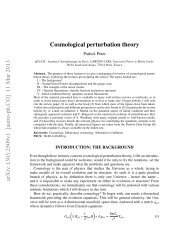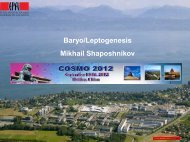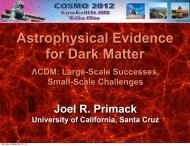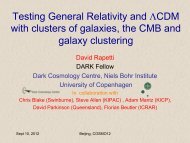Large-Scale Structure of the Universe and Cosmological ...
Large-Scale Structure of the Universe and Cosmological ...
Large-Scale Structure of the Universe and Cosmological ...
You also want an ePaper? Increase the reach of your titles
YUMPU automatically turns print PDFs into web optimized ePapers that Google loves.
is positive <strong>and</strong> compact in Fourier space <strong>and</strong> 〈ˆg〉 ≃ f, so that to keep <strong>the</strong><br />
interpretation <strong>of</strong> <strong>the</strong> power in this new representation as giving <strong>the</strong> power<br />
centered about some well-defined scale [294,296].<br />
The above line <strong>of</strong> thoughts can in fact be pushed even fur<strong>the</strong>r by applying <strong>the</strong><br />
so called “pre-whitening” technique to ˆ f: if ˆ f is decomposed in terms <strong>of</strong> signal<br />
plus noise, pre-whitening basically consists in multiplying ˆ f by a function h<br />
such that <strong>the</strong> noise becomes white or constant. If <strong>the</strong> noise is uncorrelated, this<br />
method allows one to diagonalize simultaneously <strong>the</strong> covariance matrix <strong>of</strong> <strong>the</strong><br />
signal <strong>and</strong> <strong>the</strong> noise. When non-Gaussian contributions to <strong>the</strong> power spectrum<br />
covariance matrix are included, however, such a diagonalization is not possible<br />
anymore. However, in <strong>the</strong> FKP approximation, as described in <strong>the</strong> previous<br />
section, it was shown that an approximate diagonalization (where two <strong>of</strong> <strong>the</strong><br />
contributions coming from two- <strong>and</strong> four-point functions are exactly diagonal,<br />
whereas <strong>the</strong> third coming from <strong>the</strong> three-point function is not) works extremely<br />
well, at least when non-Gaussianity is modeled by <strong>the</strong> hierarchical ansatz [296].<br />
The quantity whose covariance matrix has <strong>the</strong>se properties corresponds to<br />
<strong>the</strong> so-called prewhitened power spectrum, which is easiest written in real<br />
space [296]<br />
ˆξ(r) →<br />
2 ˆ ξ(r)<br />
1 + [1 + ξ(r)] 1/2.<br />
(512)<br />
Note that in <strong>the</strong> linear regime, ˆ ξ(k) reduces to <strong>the</strong> linear power spectrum; however,<br />
unlike <strong>the</strong> non-linear power spectrum, ˆ ξ(k) has almost diagonal cosmic<br />
covariance matrix even for nonlinear modes. More details on <strong>the</strong> <strong>the</strong>ory <strong>and</strong><br />
applications to observations can be found in e.g. [296,297] <strong>and</strong> [298,487,299]<br />
respectively.<br />
6.11.4 Data Compression <strong>and</strong> <strong>the</strong> Karhunen-Loève Transform<br />
A problem to face is with modern surveys such as <strong>the</strong> 2dFGRS <strong>and</strong> SDSS,<br />
is that <strong>the</strong> data set ˆx becomes quite large for “brute force” application <strong>of</strong><br />
estimation techniques. Before statistical treatment <strong>of</strong> <strong>the</strong> data as discussed in<br />
<strong>the</strong> previous sections, it might be necessary to find a way to reduce <strong>the</strong>ir size,<br />
but keeping as much information as possible. The (discrete) Karhunen-Loève<br />
transform (KL) provides a fairly simple method to do that (see e.g. [680,646]<br />
<strong>and</strong> references <strong>the</strong>rein for more technical details <strong>and</strong> e.g. [487,443] for practical<br />
applications to observations). Basically, <strong>the</strong> idea is to work in <strong>the</strong> space <strong>of</strong><br />
eigenvectors Ψj <strong>of</strong> <strong>the</strong> cross-correlation matrix M ≡ 〈δˆx · δˆx t 〉, i.e. to diagonalize<br />
<strong>the</strong> cosmic covariance matrix <strong>of</strong> <strong>the</strong> data,<br />
M · Ψj = λj Ψj, (513)<br />
where <strong>the</strong> matrix Ψ is unitary, Ψ −1 = Ψ t . A new set <strong>of</strong> data, ˆy, can be defined<br />
ˆy ≡ Ψ t · ˆx, (514)<br />
177















